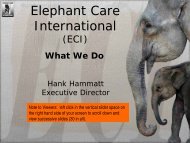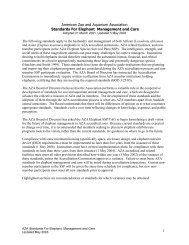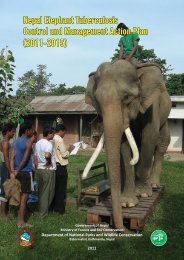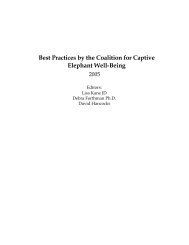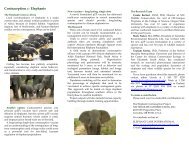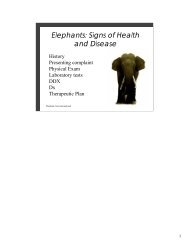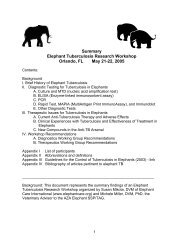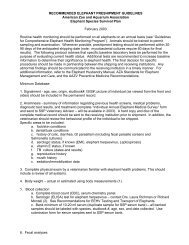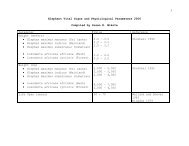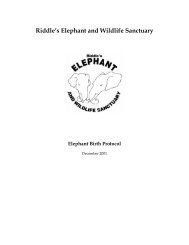elephant research and tissue request protocol - Elephant Care ...
elephant research and tissue request protocol - Elephant Care ...
elephant research and tissue request protocol - Elephant Care ...
You also want an ePaper? Increase the reach of your titles
YUMPU automatically turns print PDFs into web optimized ePapers that Google loves.
ELEPHANT RESEARCH AND TISSUE<br />
REQUEST PROTOCOL<br />
(Elephas maximus <strong>and</strong> Loxodonta africana)<br />
The American Zoo <strong>and</strong> Aquarium Association<br />
<strong>Elephant</strong> Species Survival Plan<br />
And<br />
The <strong>Elephant</strong> Research Foundation<br />
August, 2006
<strong>Elephant</strong> Research Protocol, page 2<br />
TABLE OF CONTENTS<br />
Introduction..........................................................................................................................3<br />
<strong>Elephant</strong> Herpesvirus Alert..................................................................................................4<br />
<strong>Elephant</strong> Tuberculosis Alert ................................................................................................5<br />
Internet Sites……………..…………………………….………………………………….6<br />
Search List ...........................................................................................................................6<br />
Research Requests ......................................................................................................... 7-12<br />
Form for Requesting <strong>Elephant</strong> Tissue/Blood Samples………………….…………..…...13<br />
<strong>Elephant</strong> Serum Bank Submission Form……….……………..…………………………14<br />
Measurements Checklist .............................................................................................. 15-18<br />
Selected Bibliography……………………………………………………...…………….19
<strong>Elephant</strong> Research Protocol, page 3<br />
INTRODUCTION<br />
This <strong>protocol</strong> is an effort of the <strong>Elephant</strong> Species Survival Plan (SSP) Propagation Group<br />
of the American Zoo <strong>and</strong> Aquarium Association (AZA) <strong>and</strong> the <strong>Elephant</strong> Research<br />
Foundation. Its purpose is to provide a format for the systematic collection of<br />
information <strong>and</strong> samples that will add to our knowledge of <strong>elephant</strong>s. All North<br />
American institutions holding <strong>elephant</strong>s will receive a copy.<br />
We hope that most institutions will not have to face the immense task of immobilizing or<br />
performing an <strong>elephant</strong> necropsy, but this occur, it should be viewed as an important<br />
learning opportunity. Although it may not be feasible to collect all the information <strong>and</strong><br />
samples <strong>request</strong>ed, we encourage the collection of as much as possible. With the<br />
increased availability of digital cameras, it is strongly recommended that photographs of<br />
both normal <strong>and</strong> pathologic structures be recorded for future reference.<br />
Sample <strong>and</strong> data collection information for <strong>research</strong> is contained in this document.<br />
(Specific necropsy information is contained in a separate document, <strong>Elephant</strong> Necropsy<br />
Protocol.) The Search List describes those parts of the anatomy for which data is lacking<br />
or about which previous observations need to be confirmed or refuted. The<br />
Measurements Checklist may seem tedious, but only this type of attention to detail will<br />
allow us to exp<strong>and</strong> our knowledge of <strong>elephant</strong> anatomy. Both of these <strong>request</strong>ed data sets<br />
are optional <strong>and</strong> included in this document. Some of these observations may be applied<br />
to live animals. Therefore, this <strong>protocol</strong> should be referred to when planning a procedure<br />
that might facilitate data collection. Please send the completed measurements checklist<br />
to Dr. J. Shoshani (contact information on page 11) <strong>and</strong> a copy to Dr. Michele Miller.<br />
Acquainting oneself with the <strong>protocol</strong>s in both documents (<strong>Elephant</strong> Necropsy Protocol<br />
<strong>and</strong> <strong>Elephant</strong> Research <strong>and</strong> Tissue Request Protocol) <strong>and</strong> having the necessary equipment<br />
ready will facilitate sample collection. A team should be designated in advance for data<br />
<strong>and</strong> sample collection to save valuable time. A list of <strong>research</strong>ers interested in<br />
participating in <strong>elephant</strong> necropsies is included in the <strong>Elephant</strong> Necropsy Protocol.<br />
A revised <strong>Elephant</strong> Research <strong>and</strong> Tissue Protocol will be forwarded periodically as new<br />
<strong>request</strong>s are received <strong>and</strong> projects end. Contact Dr. Michele Miller or Scott Terrell for<br />
current <strong>request</strong>s. A copy of the completed data should be sent to the appropriate<br />
<strong>research</strong>er. A copy of the necropsy report should be completed <strong>and</strong> sent to Drs. Scott<br />
Terrell <strong>and</strong> Genny Dumonceaux (see <strong>Elephant</strong> Necropsy Protocol for details).<br />
Scott P. Terrell, DVM, Diplomate ACVP<br />
SSP Pathology Advisor<br />
Disney’s Animal Kingdom, 1200 N Savannah Circle, Bay Lake, FL 32830,<br />
W (407) 938-2746; H (407) 251-0545; Cell (321)229-9363<br />
email Scott.P.Terrell@disney.com
<strong>Elephant</strong> Research Protocol, page 4<br />
ELEPHANT HERPESVIRUS DISEASE ALERT<br />
The cause of a highly fatal disease of <strong>elephant</strong>s in North American <strong>and</strong> European Zoos<br />
has been identified recently as a new type of herpesvirus. The herpesvirus affects mainly<br />
young <strong>elephant</strong>s <strong>and</strong> usually has a fatal outcome within an hour to a week of onset.<br />
Clinical signs are variable <strong>and</strong> include lethargy, edematous swellings of the head <strong>and</strong><br />
thoracic limbs, oral ulceration <strong>and</strong> cyanosis of the tongue. Necropsy findings include<br />
extensive cardiac <strong>and</strong> serosal hemorrhages <strong>and</strong> edema, hydropericardium, cyanosis of the<br />
tongue <strong>and</strong> oral <strong>and</strong> intestinal ulcers. Histological features are microhemorrhages with<br />
very mild inflammation in the heart, liver <strong>and</strong> tongue accompanied by intranuclear<br />
inclusion bodies in the capillary endothelium. Transmission electron microscopy of the<br />
inclusion bodies shows 80-90 nm diameter viral capsids consistent with herpesvirus<br />
morphology.<br />
Serological tests have been recently developed (2002) using molecular techniques to<br />
express antigens because it has not been possible to cultivate the virus in vitro. Some of<br />
the epidemiological aspects of the disease are not yet clear <strong>and</strong> are still under study.<br />
Although African <strong>elephant</strong>s are known to carry the virus that is fatal for Asian <strong>elephant</strong>s,<br />
there have been a number of cases in Asian <strong>elephant</strong>s in which no direct contact occurred<br />
with African <strong>elephant</strong>s. Asian calves (less than two years of age) from different facilities<br />
in the U.S. became ill with the clinical signs noted above, <strong>and</strong> were found to have the<br />
herpesvirus by a blood test using polymerase chain reaction (PCR). Of seven <strong>elephant</strong>s<br />
that were treated with famciclovir, three recovered. The onset of the disease may be very<br />
rapid with few prodromal signs <strong>and</strong> percute death within 24 to 36 hours. This occurred in<br />
1999-2000 in a six <strong>and</strong> eight year old Asian <strong>elephant</strong> that both died even through<br />
famciclovir was administered several hours after herpes infection was suspected.<br />
If you suspect an <strong>elephant</strong> in your care may have died from this disease or shows clinical<br />
signs, please contact one of the principals listed below. Consult the Tissue Checklist<br />
section of this necropsy <strong>protocol</strong> for instructions on sending diagnostic samples from any<br />
<strong>elephant</strong>s suspected of having this disease. Serum samples from sick or dead<br />
<strong>elephant</strong>s should be obtained for diagnostic testing in any suspected case of<br />
herpesvirus infection.<br />
Contacts: Laura K. Richman<br />
Pathologist/Scientist II<br />
MedImmune, Inc.<br />
One MedImmune Way<br />
Gaithersburg, MD 20878<br />
W: (301) 398-4741; e-fax (301) 398-9741; RichmanL@MedImmune.com<br />
Scott P. Terrell, Disney’s Animal Kingdom, Orl<strong>and</strong>o, FL. W: 407-938-2746, H: 407-251-<br />
0545, Cell: 321-229-9363; Email: Scott.P.Terrell@disney.com<br />
Michele Miller Work: (407) 939-7316 Fax: (407) 938-1909<br />
Disney’s Animal Kingdom<br />
Email: Michele.Miller@disney.com<br />
Department of Veterinary Services<br />
P.O. Box 10,000 Lake Buena Vista, FL 32830-1000 FOR HELP WITH TREATMENT ADVICE
<strong>Elephant</strong> Research Protocol, page 5<br />
ELEPHANT TUBERCULOSIS ALERT<br />
An intense search for lesions of tuberculosis (TB) is encouraged in all <strong>elephant</strong> necropsies. This should<br />
include all <strong>elephant</strong>s that die or are euthanized for other reasons even though TB is not suspected.<br />
Be advised that <strong>elephant</strong> TB is likely to be caused by Mycobacterium tuberculosis which is contagious to<br />
humans. Therefore be prepared with proper protective apparel, <strong>and</strong> contain any suspicious organs or<br />
lesions as soon as possible.<br />
Ideally, <strong>elephant</strong>s should be bled for serology (RAPID TEST, MAPIA), <strong>and</strong> trunk wash(es) collected just<br />
prior to euthanasia. <strong>Elephant</strong>s that die naturally should have a post mortem trunk wash performed <strong>and</strong><br />
serum should be harvested from post mortem blood for serological assays. Consult the Guidelines for the<br />
Control of Tuberculosis in <strong>Elephant</strong>s 2003 ( www.aphis.usda.gov/ac/TBGuidelines2003.html ).<br />
Protective equipment for tuberculosis cases<br />
Respiratory protective equipment should be available during any <strong>elephant</strong> necropsy procedure regardless of<br />
the historical TB testing status of the animal. In animals with an unknown, suspect, or positive TB test<br />
history, respiratory protection is m<strong>and</strong>atory. OSHA st<strong>and</strong>ards (29CFR1910.134) require that “workers<br />
present during the performance of high hazard procedures on individuals (humans) with suspicious or<br />
confirmed TB” be given access to protective respirators (at least N-95 level masks). Similar precautions<br />
should be taken during an <strong>elephant</strong> necropsy. According to the draft CDC guidelines for the prevention of<br />
transmission of tuberculosis in health care settings, respiratory protective devices used for protection<br />
against M. tuberculosis should meet the following criteria:<br />
1. Particulate filter respirators approved include (N-,R-, or P-95,99,or 100) disposable<br />
respirators or positive air pressure respirators (PAPRs) with high efficiency filters)<br />
2. Ability to adequately fit wearers who are included in a formal respiratory protection program<br />
with well-fitting respirators such as those with a fit factor of greater than or equal to 100 for<br />
disposable or other half-mask respirators<br />
3. Ability to fit the different face sizes <strong>and</strong> characteristics of wearers. This can usually be met<br />
by supplying respirators in at least 3 sizes. PAPRs may work better than half-masks for those<br />
persons with facial hair.<br />
See website links below for OSHA <strong>and</strong> CDC guidelines.<br />
Necropsy procedures<br />
All <strong>elephant</strong>s undergoing necropsies should have a careful examination of the tonsillar regions <strong>and</strong><br />
subm<strong>and</strong>ibular lymph nodes for tuberculous appearing lesions. These lymph nodes may be more easily<br />
visualized following removal of the tongue <strong>and</strong> laryngeal structures during the dissection. All lymph nodes<br />
should be carefully evaluated for lesions since other sites may also be infected (ex. reproductive or<br />
gastrointestinal tract). Take any nodes that appear caseous or granulomatous for culture (freeze or<br />
ultrafreeze), <strong>and</strong> fixation (in buffered 10% formalin). In addition, search thoracic organs carefully for early<br />
stages of TB as follows: after removal of the lungs <strong>and</strong> trachea, locate the bronchial nodes at the junction of<br />
the bronchi from the trachea. Use clean or sterile instruments to section the nodes. Freeze half of the<br />
lymph node <strong>and</strong> submit for TB culture to NVSL or a laboratory experienced in mycobacterial culture <strong>and</strong><br />
identification (even if no lesions are evident). Submit sections in formalin for histopathology. <strong>Care</strong>fully<br />
palpate the lobes of both lungs from the apices to the caudal borders to detect any firm B-B shot to nodular<br />
size lesions. Take NUMEROUS (5 or more) sections of any suspicious lesions. Open the trachea <strong>and</strong><br />
look for nodules or plaques <strong>and</strong> process as above. Regional thoracic <strong>and</strong> tracheal lymph nodes should also<br />
be examined <strong>and</strong> processed accordingly. Split the trunk from the tip to its insertion <strong>and</strong> take samples of<br />
any plaques, nodules or suspicious areas for TB diagnosis as above. Look for <strong>and</strong> collect possible extrathoracic<br />
TB lesions, particularly if there is evidence of advanced pulmonary TB.<br />
For further information on laboratories performing diagnostic tests for TB, consult Guidelines for the<br />
Control of Tuberculosis in <strong>Elephant</strong>s 2003. In the event of an <strong>elephant</strong> necropsy (elective or otherwise),<br />
please notify Dr. Terrell (see contact list) for further instructions <strong>and</strong> possible participation.
<strong>Elephant</strong> Research Protocol, page 6<br />
Contacts: Scott P. Terrell, DVM, Diplomate ACVP, SSP Pathology Advisor,<br />
Disney’s Animal Kingdom, 1200 N Savannah Circle, Bay Lake, FL 32830,<br />
W (407) 938-2746; H (407) 251-0545; Cell (321)229-9363; email<br />
Scott.P.Terrell@disney.com<br />
INTERNET SITES<br />
These guidelines <strong>and</strong> other <strong>elephant</strong> <strong>protocol</strong>s are available on the internet at the following sites:<br />
1. www.aphis.usda.gov/ac/TBGuidelines2003.html (available to the public)<br />
2. www.aazv.org (available to AAZV members by password)<br />
3. www.<strong>elephant</strong>care.org (available to the public)<br />
4. http://www.osha.gov/SLTC/tuberculosis/st<strong>and</strong>ards.html - OSHA TB st<strong>and</strong>ards <strong>and</strong> rules<br />
5. http://www.cdc.gov/nchstp/tb/Federal_Register/New_Guidelines/TBICGuidelines.pdf<br />
Guidelines for Preventing the Transmission of Mycobacterium tuberculosis in<br />
Health-<strong>Care</strong> Settings, 2005<br />
SEARCH LIST (OPTIONAL)<br />
The following are anatomical features that need to be confirmed or refuted, or for which few data exist.<br />
They are not arranged in order of importance, but rather as one studies the <strong>elephant</strong> by regions from the tip<br />
of the trunk to the tip of the tail. Please be aware of these anatomical questions <strong>and</strong> attempt to obtain the<br />
needed additional data as you proceed in your dissection.<br />
1. Record the number of toenails.<br />
2. Weigh skin after dissection from limbs <strong>and</strong> carcass.<br />
3. Search for sesamoids especially under tendons. There may be one at the proximal end of the humerus,<br />
but check other sites as well.<br />
4. Obtain total skeletal weight. Remove as much soft <strong>tissue</strong> as possible.<br />
5. Note any pathological conditions in the joints. Slight erosions on articular surfaces can be viewed best<br />
in fresh <strong>tissue</strong>s <strong>and</strong> should be examined soon after death. Grooves <strong>and</strong> fractures on articular surfaces<br />
cannot be mistaken <strong>and</strong> should be sought. Look also for "joint mice," calcium deposits, <strong>and</strong> any other<br />
abnormal signs.<br />
6. Measure the volume of the nasal passages by instilling water soon after death or by measuring the<br />
diameter of the passages at intervals (record total length of trunk <strong>and</strong> diameter of passages at intervals<br />
of 10 cm).<br />
7. Look for the intercommunicating canal between the two nasal passages of the trunk <strong>and</strong> the associated<br />
fibrous arches by sectioning the trunk every 10-20 cm. These structures were described as being<br />
located 13 cm from the tip of the trunk in a young female Asian <strong>elephant</strong>. Other searches in adult<br />
Asian females have revealed neither the arches nor the canals (Shoshani et al., 1982).<br />
8. Harvest the lenses from the eyes <strong>and</strong> weigh them (or keep intact eyes frozen).<br />
9. Search for the trachea-esophageal muscle. This muscle is small <strong>and</strong> may be overlooked or cut during<br />
dissection so we suggest that a section about 20 cm posterior <strong>and</strong> 50 cm or more anterior to the<br />
bifurcation be removed <strong>and</strong> examined carefully outside the carcass. This muscle was found in only<br />
three of twelve <strong>elephant</strong>s examined (Shoshani et al., 1982).<br />
10. Examine the dividing arrangement of the arteries from the aortic arch. There are two possibilities three<br />
branches or two branches. In the three-branch arrangement the sequence is right subclavian, a trunk<br />
common to the two carotids <strong>and</strong> the left subclavian. In the two-branch arrangement, the right<br />
subclavian <strong>and</strong> the common carotids merge into one vessel <strong>and</strong> the left subclavian remains separate.
<strong>Elephant</strong> Research Protocol, page 7<br />
RESEARCH REQUESTS<br />
Institutional reminder - all <strong>request</strong>s made are conditional <strong>and</strong><br />
not automatic, <strong>and</strong> may require the <strong>research</strong>er’s presence if<br />
they want detailed measurement info <strong>and</strong>/or complicated<br />
samples that are difficult to obtain <strong>and</strong> ship. Please contact<br />
the <strong>research</strong>ers in advance if you would like help in the<br />
collection of more complicated / labor intensive samples.<br />
These <strong>request</strong>s are not a requirement for completion of a<br />
detailed diagnostic necropsy.
<strong>Elephant</strong> Research Protocol, page 8<br />
1. Dr. Bets Rasmussen<br />
Professor of Biochemistry Work: 503-748-1263<br />
Oregon Graduate Institute Home: 503-621-1435<br />
20,000 NW Walker Rd Fax: 503-748-1464<br />
Beaverton, Oregon 97006 USA Email: betsr@ebs.ogi.edu<br />
Cell: 971-645-9485<br />
For any MALE ELEPHANT please call Bets Rasmussen immediately at 503-748-1263 or 503-621-1435.<br />
She will come on the next airplane as certain <strong>tissue</strong>s are of extreme <strong>and</strong> immediate value in her studies.<br />
Frozen at liquid nitrogen temperatures <strong>and</strong> maintained at dry ice temperature for shipping. Small<br />
pieces ( 1cm by0.5cm) in cryo tubes<br />
1. temporal galnd 2. Palatal pits 3. Incisive duct openings 4. Olfactory <strong>tissue</strong> 5. Liver 6. ovary<br />
Fixatives. Fixatives are available from Dr. Rasmussen. If there is an immediate need, contact your local<br />
medical school. Preferred fixative is 4% glutaraldehyde (EM grade) in a pH 7.2 buffer. Cut pieces for EM<br />
0.5cm 3 . Save (in 10% buffered formalin) the larger section from which the EM piece was taken. If<br />
glutaraldehyde is not available submit <strong>tissue</strong>s in 10% buffered formalin.<br />
Vomeronasal organ (RNA & DNA studies; electron microscopy). See diagram a. Adults: Only the<br />
incisive ducts are <strong>request</strong>ed. These paired openings on the roof of the mouth are 1-2 cm in diameter,<br />
several cms posterior to the juncture of the mucosa of the mouth with the lip region.<br />
Fetal, neonates & young <strong>elephant</strong>s. The whole vomeronasal organ is <strong>request</strong>ed. It is found in the vomer<br />
bone, dorsal <strong>and</strong> posterior to the incisive ducts. It is paired, pear-shaped <strong>and</strong> surrounded by cartilage. In<br />
immediately post-natal <strong>elephant</strong>s it does not connect with the ducts. In these young <strong>elephant</strong>s to obtain the<br />
organ, work dorsal/posteriorly from the ducts, looking for shiny white cartilage surrounding receptive<br />
<strong>tissue</strong>, which is hollow in the center. FIRST<br />
PRIORITY is (1cm 3 ) pieces frozen in cryotubes in<br />
liquid nitrogen. Second priority is fixed <strong>tissue</strong>.<br />
Palatal pits. (Histological <strong>and</strong> cytological studies.)<br />
The palatal pits are dual series of small (smaller<br />
than VNO duct opening) openings (0-13),<br />
asymmetrically <strong>and</strong> bilaterally located along the<br />
approximate demarcation line in the upper head<br />
between the hard palate <strong>and</strong> the trunk. Push aside<br />
the upper lip to locate. Dissect out a pit (0.5-<br />
1.0cm), making sure at least 2 cm of underlying<br />
<strong>tissue</strong> are included (4% buffered glutaraldehyde).<br />
Brain. The anterior, olfactory bulb region is<br />
<strong>request</strong>ed if the brain is being removed. Especially<br />
the anterior-ventral region where connections to<br />
olfactory turbinates <strong>and</strong> vomeronasal nerve occur.<br />
This is a special <strong>request</strong> <strong>and</strong> Dr. Rasmussen will be<br />
present for such procurement.
<strong>Elephant</strong> Research Protocol, page 9<br />
2. Dr. C. Earle Pope<br />
Audubon Center for Research of Endangered Species (ACRES)<br />
14001 River Road<br />
New Orleans, Louisiana, 70131 USA<br />
Work: (504) 398-3161 Home: (504) 734-5381 Fax: (504) 391-7707 Email: epope@acres.org<br />
Intact ovaries (To recover oocytes for in vitro maturation <strong>and</strong> culture). Remove ASAP; rinse with saline<br />
to remove blood <strong>and</strong> adhering <strong>tissue</strong>. Wrap in sterile gauze pre-soaked in saline <strong>and</strong> place in plastic bag or<br />
specimen container. Keep at room temperature if sample can be shipped the same day; if longer, pack in<br />
crushed ice. Ship overnight; will pay shipping.<br />
3. Dr. Linda Munson<br />
Department of Veterinary Pathology, Microbiology Immunology<br />
University of California at Davis<br />
1126 Haring Hall / One Shields Ave.<br />
Davis, CA 95616 USA<br />
Work: 530-754-7567 Fax: 530-752-3349 Email: lmunson@ucdavis.edu<br />
Sections of uterine endometrium (Characterization of endometrial lesions.) Endometrial samples<br />
including any polyps, cysts, tumors or other lesions. Samples should include lesion <strong>and</strong> adjacent normal<br />
<strong>tissue</strong>. Fix in 10% formalin. Ship by U.S. mail. Will pay shipping.<br />
4. Dr. Scott Terrell<br />
Disney’s Animal Kingdom<br />
1200 N Savannah Circle<br />
Bay Lake, FL 32830<br />
Work: (407) 938-2746 Home (407) 251-0545 Fax: (407) 938-1909<br />
Email: Scott.P.Terrell@disney.com<br />
One complete set of histopathology H&E slide recuts for review.<br />
Complete set of formalin fixed <strong>tissue</strong>s (as per SSP Necropsy Protocol). For formalin fixed <strong>tissue</strong>s 0.5-<br />
1.0cm thick sections. Call before shipping. Will pay shipping. Dr. Terrell will review histopathology<br />
slides if pathology services are not available.<br />
A complete set of formalin fixed <strong>tissue</strong>s is required only if your institution does not retain possession<br />
of those <strong>tissue</strong>s in perpetuity. If the <strong>tissue</strong>s will be or may be disposed of at any time in the future,<br />
please send them to Dr. Terrell. The <strong>tissue</strong>s will be kept archived forever.
<strong>Elephant</strong> Research Protocol, page 10<br />
5. Laura K. Richman, DVM, PhD, Diplomate, ACVP<br />
Pathologist/Scientist II<br />
MedImmune, Inc.<br />
One MedImmune Way<br />
Gaithersburg, MD 20878<br />
W: (301) 398-4741; e-fax (301) 398-9741; RichmanL@MedImmune.com<br />
1. Ultra frozen (-70 °C ) heart, liver, tongue, spleen, oral ulcers <strong>and</strong> lymphoid patch sections from<br />
distal vestibulum. 2. Whole blood (5-10 ml); serum (5-10 ml). (For <strong>elephant</strong> herpes virus study). Take<br />
samples to be frozen as soon as possible place in sterile container <strong>and</strong> freeze. Send frozen <strong>tissue</strong> overnight<br />
on dry ice. Send blood <strong>and</strong> serum samples overnight on wet or dry ice. Call before shipping. Will pay<br />
shipping.<br />
6. Anthony T. Boldurian, Ph.D.<br />
Professor of Anthropology<br />
University of Pittsburgh at Greensburg<br />
Smith Science Building<br />
1150 Mt. Pleasant Road<br />
Greensburg, Pennsylvania, 15601 USA<br />
Work: (724) 836-9989 Fax: (724) 836-7129 E-mail: folsom@pitt.edu<br />
Femur or humerus from either species; adult or sub-adult. (For experimental archeological study to<br />
replicate mammoth shaft wrench artifact.) Minimum width 60 mm; minimum thickness 20 mm. Samples<br />
must be in a “green” or unweathered state, preferably from a recently deceased individual. Pack in ice or<br />
cool packs if <strong>tissue</strong> still adhering. Call before shipping. Will pay shipping.<br />
7. Mark Stetter, DVM, DACZM<br />
Director of Veterinary Services<br />
Disney’s Animal Programs<br />
Department of Veterinary Services<br />
P.O. Box 10,000<br />
Lake Buena Vista, Florida 32830-1000 USA<br />
Work: (407) 939-7352 Fax: (407) 938-1909 E-mail: Mark.Stetter@disney.com<br />
Please call if an <strong>elephant</strong> euthanasia is being planned. Project involves abdominal laparoscopy for<br />
developing reproductive intervention methods (vasectomy/ovariectomy).<br />
8. Michele Miller, DVM, PhD<br />
Disney’s Animal Kingdom<br />
Department of Veterinary Services<br />
1200 N. Savannah Circle East<br />
Bay Lake, Florida 32830<br />
Work: (407) 939-7316 Fax: (407) 938-1909 E-mail: Michele.Miller@disney.com<br />
Minimum 5-10 ml frozen serum for SSP serum bank. Instructions for sample preparation: Serum<br />
samples should be separated within 1 hr of collection <strong>and</strong> frozen in 1-2 ml aliquots in cryovials. Freeze at –<br />
70C until shipment. Ship on dry ice or ice packs overnight to address above. Please complete serum bank<br />
submission form (see below) <strong>and</strong> send with shipment.
<strong>Elephant</strong> Research Protocol, page 11<br />
9. Dr. Fahad Sultan<br />
Department of Cognitive Neurology, University Tubingen<br />
Auf der Morgenstelle 15<br />
72076 Tubingen, Germany<br />
Work: +49-7071-2980464 Fax: +49-7071-295724 E-mail: fahad.sultan@uni-tuebingen.de<br />
Cell: 0160 98730310<br />
Intact <strong>elephant</strong> brain immersed in 3.5% paraformaldehyde. (For neurologic study) Studying quantitative<br />
comparative neuroanatomical aspects of mammalian cerebella. Part of the <strong>research</strong> has been dealing with<br />
the size <strong>and</strong> form of the unfolded cerebellar cortex. Duration of study: 2-5 years. Special instructions:<br />
Brains should be as intact as possible (after careful removal from skull), immerxe in 3.5%<br />
paraformaldehyde fixative. Researcher will pay for shipping. CITES permit for shipping samples required.<br />
10. Name: Robin Dunkin <strong>and</strong> Dr. Terrie Williams<br />
Date of Request: 2-20-2005<br />
Affiliation: University of California at Santa Cruz<br />
Address: Center for Ocean Health<br />
100 Shaffer Road<br />
Santa Cruz, CA 95060<br />
Work phone: (831) 334-0640 or (831) 459-5428 Fax: (831) 459 – 3383<br />
Email: dunkin@biology.ucsc.edu or williams@biology.ucsc.edu<br />
REQUEST FOR ELEPHANT TISSUE/BLOOD SAMPLES<br />
Sample(s) Requested<br />
We are <strong>request</strong>ing samples (~30cm 2 ) of full depth, dorsal integument from both Asian <strong>and</strong> African<br />
<strong>elephant</strong>s.<br />
Purpose of Study<br />
We are conducting a study of the thermal properties of <strong>elephant</strong> integument as part of a larger project on<br />
<strong>elephant</strong> thermoregulation <strong>and</strong> water conservation. These samples will be used to measure thermal<br />
conductivity <strong>and</strong> conductance of the integument both in its dry state as well with water or mud coating the<br />
surface of the skin.<br />
Duration of the Study<br />
Approximately 4-5 years<br />
Instructions for Sample Preparation<br />
The sample should be collected from the dorsal surface at the level of the umbilicus. Sample dimensions<br />
should be roughly 30cm 2 <strong>and</strong> should include the full depth of the integument. Alternatively, other areas on<br />
the dorsal surface are acceptable, however, the location where the sample was taken should be noted. The<br />
sample should be collected <strong>and</strong> then notched at the dorso-cranial margin to maintain orientation. The<br />
sample should then be wrapped in Saran-wrap, double bagged in a zip-lock bag, <strong>and</strong> frozen until shipped.<br />
Shipping Instructions<br />
Samples should be shipped with either ice packs or dry ice. Samples should be shipped overnight <strong>and</strong> we<br />
are happy to pay for shipping <strong>and</strong> packaging supplies.<br />
Special Instructions<br />
Along with the sample, we would like to <strong>request</strong> some basic information on the animal including age, sex,<br />
mass, whether the animal was in robust or emaciated body condition, <strong>and</strong> whether any skin lesions or other<br />
skin problems were present<br />
11. Dr. Jeheskel (Hezy) Shoshani or Dr. William Kupsky<br />
<strong>Elephant</strong> Research Foundation<br />
Phone: (313) 745-2542; email: wkupsky@dmc.org<br />
106 East Hickory Grove Road or Gary Marchant<br />
Bloomfield Hills, Michigan 48304 USA<br />
Phone: (248) 559-2278; email: merchant@ic.net
<strong>Elephant</strong> Research Protocol, page 12<br />
Work: (248) 540-3947 or Mahmood Mokhayesh<br />
Email: jshosh@sun.science.wayne.edu Phone: (313) 557-2872;<br />
email: carnassial@hotmail.com<br />
Intact brain from any age, sex or species of <strong>elephant</strong>. Preserve in 10% formalin.<br />
Copy of completed measurements checklist (Anatomical studies).<br />
Please send to Dr. Shoshani.<br />
12. Tim Griffin <strong>and</strong> Chelsea He<br />
Orthopedic Bioengineering Laboratory<br />
Duke University Medical Center<br />
375 MSRB, DUMC Box 3093<br />
Duke University Medical Center<br />
Durham, NC 27710<br />
Email: tmgriff@duke.edu<br />
chlesea.he@duke.edu<br />
Work: 919-684-3583 Home: 919-931-4260 Fax: 919-681-8490<br />
We are interested in studying how cartilage biomechanical properties vary in animals that span a wide<br />
range of body sizes in order to characterize the relationship between body mass, cell density, <strong>and</strong> <strong>tissue</strong><br />
mechanical properties.<br />
Sample <strong>request</strong>ed: Intact knee joint<br />
Duration of study: Open<br />
Instructions / sample: Refigerate joint within 24 hours of animal’s death. Freeze within 72 hours. Femoral<br />
shaft can be cut proximal to the knee joint <strong>and</strong> tibial shaft distal to the knee. Skin <strong>and</strong> muscle can be<br />
trimmed or left intact. Please do not open knee capsule.<br />
Shipping: Recipient will pay, ship in sealed bag on dry ice.
REQUEST FOR ELEPHANT TISSUE/BLOOD SAMPLES<br />
<strong>Elephant</strong> Research Protocol, page 13<br />
Name ____________________________________________Date of <strong>request</strong>_______________________________________<br />
Affiliation ____________________________________________________________________________________________<br />
Address ______________________________________________________________________________________________<br />
Work phone (___)__________________________ Home phone (____)__________________________________________<br />
Fax (____)________________________________<br />
Email _____________________________________________________<br />
Sample(s)<strong>request</strong>ed ____________________________________________________________________________________<br />
_____________________________________________________________________________________________________<br />
_____________________________________________________________________________________________________<br />
_____________________________________________________________________________________________________<br />
_____________________________________________________________________________________________________<br />
Purpose of study ______________________________________________________________________________________<br />
_____________________________________________________________________________________________________<br />
_____________________________________________________________________________________________________<br />
_____________________________________________________________________________________________________<br />
Duration of study _____________________________________________________________________________________<br />
Instructions for sample preparation ______________________________________________________________________<br />
_____________________________________________________________________________________________________<br />
_____________________________________________________________________________________________________<br />
_____________________________________________________________________________________________________<br />
Shipping instructions (dry ice? Overnight? Will you pay for shipping?) ________________________________________<br />
Special instructions ____________________________________________________________________________________<br />
_____________________________________________________________________________________________________<br />
_____________________________________________________________________________________________________<br />
Attach any additional information. Send to:Michele Miller, Disney’s Animal Kingdom, Department of Veterinary Services,<br />
P.O. Box 10,000, Lake Buena Vista, Florida 32830-1000. Work: (407) 939-7316;<br />
Fax: (407) 938-1909; Email:Michele.Miller@disney.com
<strong>Elephant</strong> Research Protocol, page 14<br />
<strong>Elephant</strong> Serum Bank Submission Form<br />
Institution/owner: _____________________________________________________<br />
Submitter:<br />
_____________________________________________________<br />
Address: _____________________________________________________<br />
_____________________________________________________<br />
Tel: _________________ Fax: _____________ Email: ______________________<br />
Animal Information<br />
Asian [ ] African [ ] ISIS# ____________ Studbook # ______________<br />
Name ______________________ Age: _________ [ ] actual [ ] estimate<br />
Sex: [ ] male [ ] female<br />
SAMPLE COLLECTION INFORMATION<br />
Date of sample collection: ___________ Time of collection : __________<br />
Site of sample collection: [ ] ear vein [ ] leg vein [ ] other: ___________<br />
Health status of animal: [ ] normal [ ] abnormal<br />
Fasted: [ ] no [ ] yes – how long ______________<br />
Weight ________________ [ ] actual [ ] estimated<br />
Type of restraint: [ ] manual [ ] anesthetized/sedated [ ] behavioral control<br />
Temperament of animal: [ ] calm [ ] active [ ] excited<br />
Type of blood collection tube:<br />
[ ] no anticoagulant (red-top)<br />
[ ] EDTA (purple)<br />
[ ] heparin (green)<br />
[ ] other: ___________________<br />
Sample h<strong>and</strong>ling:<br />
(check all that apply)<br />
[ ] separation of plasma/serum by centrifugation<br />
[ ] stored as whole blood<br />
[ ] frozen plasma/serum<br />
[ ] other – describe _______________________<br />
TB EXPOSURE STATUS<br />
[ ] Known infected animal<br />
[ ] Known exposure to culture positive source within the past 12 months<br />
[ ] Known exposure to a culture positive source within the past 1-5 years<br />
[ ] No know exposure to a culture positive source in the last 5 years<br />
TREATMENT INFORMATION<br />
Is <strong>elephant</strong> currently receiving any medication or under treatment? [ ] yes [ ] no<br />
If yes, please list drugs <strong>and</strong> doses: ____________________________________<br />
_______________________________________________________________<br />
_______________________________________________________________<br />
_______________________________________________________________<br />
Time between blood collection <strong>and</strong> last treatment: ______________________<br />
Ship samples overnight frozen with shipping box marked “PLACE IN FREEZER UPON ARRIVAL”<br />
Send completed form with samples to:<br />
Dr. Michele Miller<br />
Disney’s Animal Kingdom-Dept. of Vet. Services<br />
1200 N. Savannah Circle West<br />
Bay Lake, FL 32830<br />
(407) 939-7316; email: Michele.Miller@disney.com<br />
2/20/03
<strong>Elephant</strong> Research Protocol, page 15<br />
MEASUREMENTS (OPTIONAL)<br />
This data sheet is a general guideline to the pre-euthanasia or post mortem measuring of an <strong>elephant</strong>. Refer to the anatomical<br />
diagrams, Figures 1 <strong>and</strong> 2. The numbering system begins at the trunk <strong>and</strong> continues in a clockwise direction. All<br />
measurements should be taken in a straight line, except when indicated otherwise. Measurements to be taken between<br />
corresponding points on opposite sides of the body are marked with a plus symbol (+). These should be taken in a straight<br />
line, essentially through, not around, the <strong>elephant</strong>. Calipers can be improvised from two long straight poles or straight edges.<br />
Place the end of each pole on one of the two points, keeping the poles parallel to one another. Measure the<br />
straight line distance between the free ends of the two parallel poles.<br />
GENERAL<br />
Subject<br />
Tip of trunk to tip of tail (along the curve)<br />
Length of trunk (along the curve)<br />
Length of tail<br />
Shoulder height<br />
Dorsum height (the highest point of back or “hump”<br />
Reference numbers<br />
on figures<br />
Fig.1: 1-9<br />
Fig.1: 1-2<br />
Fig.1: 8-9<br />
Fig.1: 5-14<br />
Fig.1: 6-13<br />
Measurement between<br />
these points (cm)
<strong>Elephant</strong> Research Protocol, page 16<br />
DETAILED<br />
TRUNK<br />
HEAD<br />
EAR<br />
NECK<br />
BODY<br />
Tip to base Fig.1: 1-2<br />
Tip width Fig.1: 1-21<br />
Base width Fig.1: 40+<br />
Dorsal length (along the curve) Fig.1: 2-3<br />
Ventral length (along the curve) Fig.1: 19-20<br />
Neck height Fig.1: 3-19<br />
Width between ears Fig.1: 38+<br />
Width between temporal gl<strong>and</strong>s Fig.1: 38a+<br />
Width between eyes Fig.1: 39+<br />
Width of mouth Fig.1: 40+<br />
Anterior width Fig.1: 22-23<br />
Posterior width Fig.1: 24-25<br />
Dorsal length Fig.1: 22-24<br />
Ventral length Fig.1: 23-25<br />
Length Fig.1: 3-4<br />
Width Fig.1: 37+<br />
Height Fig.1: 3-19<br />
Dorsal length (along the curve: Fig.1: 4-7<br />
number 7 is in a straight line with<br />
number 11)<br />
Middle length (make sure this <strong>and</strong><br />
the next measurement are taken<br />
parallel to each other)<br />
Bottom length (make sure this <strong>and</strong><br />
the previous measurement are<br />
taken parallel to each other)<br />
Fig.1: 32-26<br />
Fig.1: 10-27-18a<br />
Width at front Fig.1: 36+<br />
Width at middle Fig.1: 35+<br />
Width at back Fig.1: 34+<br />
Height at front of forelimb Fig.1: 5-27<br />
Height at front of hindlimb Fig.1: 6-30<br />
Height at back of hindlimb Fig.1: 7-10<br />
TAIL<br />
Length (excluding hair) Fig. 1: 8-9<br />
Width at base Fig. 1: 8-33
<strong>Elephant</strong> Research Protocol, page 17<br />
FORELIMB<br />
HIND LIMB<br />
DETAILED<br />
Length (height) Fig. 1: 16-26<br />
Width at top Fig. 1: 18b-28<br />
Width at bottom ( include side Fig. 1: 15-17<br />
width, if different)<br />
Length (height) Fig. 1: 11-31<br />
Width at top Fig. 1: 29-31<br />
Width at bottom (include side Fig. 1: 11-12<br />
width since it is narrower)<br />
FEET<br />
TEETH<br />
(can be measured soon after<br />
death or at a later date)<br />
Count number of “toenails”<br />
Total number of plates (including<br />
very small ones)<br />
Fig. 2A: (1b)<br />
Total length Fig. 2A: (1)<br />
Maximum width<br />
Maximum grinding length of<br />
individual teeth<br />
Maximum grinding length of<br />
entire grinding surface<br />
Fig. 2A: 3 (1a)<br />
Fig. 2A: (1a)<br />
Fig. 2A: 1b<br />
Maximum height Fig. 2A: 2<br />
Weight (in grams)<br />
Left front<br />
Right front<br />
Left hind<br />
Right hind<br />
TUSKS<br />
PENIS<br />
CLITORIS<br />
Present_____Absent_____<br />
Length from tip to gum line<br />
Length from gum line to base<br />
Length of pulp cavity<br />
Width of pulp cavity<br />
Total length<br />
Circumference at base<br />
Circumference at head<br />
Length<br />
Circumference at base<br />
Circumference at head<br />
Fig. 2B<br />
Fig. 2B: b-c<br />
Fig. 2B: a-c<br />
Fig. 2B: a-d<br />
Fig. 2B: e-e<br />
Fig. 2B: a-b
<strong>Elephant</strong> Research Protocol, page 18<br />
Figure 1. Generalized illustrations of an <strong>elephant</strong> showing points for measurement: A) after Deraniyagala<br />
(1955); all others by Shoshani. Letter “V” on the head indicates the approximate location of the vent gl<strong>and</strong>.<br />
Figure 2. Generalized illustrations of<br />
the teeth <strong>and</strong> tusk showing<br />
points for measurement.<br />
After Roth <strong>and</strong> Shoshani<br />
(1988).
LITERATURE CITED <strong>and</strong> SELECTED BIBLIOGRAPHY<br />
<strong>Elephant</strong> Research Protocol, page 19<br />
- Benedict, F.G. (1936). The physiology of the <strong>elephant</strong>. Carnegie Institution of Washington, Washington, pp. 302.<br />
- Blair, P. (1710a). Osteographia <strong>elephant</strong>ina: or, a full <strong>and</strong> exact description of all the bones of an <strong>elephant</strong> which dy’d near<br />
Dundee, April the 27th, 1706, with their several dimensions, etc. Part I. Philos Trans R Soc Lond [Biol] 27(326): 51-116.<br />
Part II. Philos Trans R Soc Lond [Biol] 27(327): 117-168.<br />
- Boas, T.E.V. <strong>and</strong> Pauli, S. (1925). The <strong>elephant</strong>’s head. The Carlsberg Fund, Copenhagen.<br />
- Deraniyagala, P.E.P. (1955). Some extinct <strong>elephant</strong>s, their relatives <strong>and</strong> the two living species. Ceylon National Museum<br />
Publ., Colombo, 161 pp.<br />
- Eales, N.B. (1925). External features, skin, <strong>and</strong> temporal gl<strong>and</strong> of a foetal African <strong>elephant</strong>. Proc Zool Soc Lond 2:445-456.<br />
- Eales, N.B. (1926). The anatomy of the head of a foetal African <strong>elephant</strong>, Elephas africanus (Loxodonta africana). Trans<br />
Roy Soc Edin 54, part III (11):491-551 plus 12 plates.<br />
- Eales, N.B. (1928). The anatomy of a foetal African <strong>elephant</strong>, Elephas africanus (Loxodonta africana) Part II. The body<br />
muscles. Trans Roy Soc Edin 55, part III (25):609-642 plus 5 plates.<br />
- Eales, N. (1929). The anatomy of a foetal African <strong>elephant</strong>, Elephas africanus (Loxodonta africana). Part III. The contents of<br />
the thorax <strong>and</strong> abdomen, <strong>and</strong> the skeleton. Trans Roy Soc Edin 56, part I (11): 203-246.<br />
- Hill, W.C.O. (1938). Studies on the cardiac anatomy of the <strong>elephant</strong>: II-the heart <strong>and</strong> great vessels of a foetal Asiatic<br />
<strong>elephant</strong>. J Sci 21:44-61.<br />
- Laursen, L. <strong>and</strong> Beckoff, M. (1978). Loxodonta africana. Mamm Species 92:1-8.<br />
- Laws, R.M. (1966). Age criteria for the African <strong>elephant</strong>, Loxodonta a. africana. East Afr Wildl J 4:1-37.<br />
- Laws, R.M. (1967). Eye lens weight <strong>and</strong> age in the African <strong>elephant</strong>. East Afr Wildl J 5:46-52.<br />
- Laws, R.M., Parker, I.S.C. <strong>and</strong> Archer, A.L. (1967). Estimating live weights of <strong>elephant</strong>s from hindleg weights. East Afr<br />
Wildl J 5:106-111.<br />
- Mariappa, D. (1986). Anatomy <strong>and</strong> histology of the Indian <strong>elephant</strong>. Indira Publishing House, Oak Park, Michigan, 209 pp.<br />
- Miall, L.C. <strong>and</strong> Greenwood, F. (1879). The anatomy of the Indian <strong>elephant</strong>. Part I. The muscles of the extremities. J Anat<br />
Physiol. 12:261-287. Part II. Muscles of the head <strong>and</strong> trunk. J Anat Physiol. 12:385-400. Part III. J Anat Physiol. 13:17-50.<br />
- Mikota, S.K., Sargent, E.L., <strong>and</strong> Ranglack, G.S. (1994). Medical management of the <strong>elephant</strong>. Indira Publishing House,<br />
West Bloomfield, Michigan, 298 pp.<br />
- Mikota, S.K., Larsen, R.S., <strong>and</strong> Montali, R.J. Tuberculosis in <strong>elephant</strong>s in North America (Zoo Biology, publication<br />
pending).<br />
- Rasmussen, L.E., <strong>and</strong> Hultgren. (1990). Gross <strong>and</strong> microscopic anatomy of the vomeronasal organ in the Asian <strong>elephant</strong>,<br />
Elephas maximus. In: Chemical signals in vertebrates 5, McDonald d., Muller-Schwarze, D., <strong>and</strong> Natynczuk, S.E., eds.,<br />
Oxford University Press, pp154-161.<br />
- Richman, L.K., Montali, R.J., Garber, R.L., Kennedy, M.A., Lehnhardt, J., Hildebr<strong>and</strong>t, T., Schmitt, D., Hardy., Alcendor,<br />
D.J., <strong>and</strong> Hayward, G.S. (1999) Novel endotheliotropic herpesvirus fatal for Asian <strong>and</strong> African <strong>elephant</strong>s. Science,<br />
283(5405): 1171-1176.<br />
- Robertson-Bullock, W. (1962). The weight of the African <strong>elephant</strong> Loxodonta africana. Proc Zool Soc Lond 138:133-135.<br />
- Rooney, J.R.,II, Sack, W.O., <strong>and</strong> Habel, R.F. (1967). Guide to the dissection of the horse. Wolfgang O. Sack, Ithaca, New<br />
York.<br />
- Roth, V.L. <strong>and</strong> Shoshani, J. (1988). Dental identification <strong>and</strong> age determination in Elephas maximus. J Zool (Lond) 214(4):<br />
567-588.<br />
- Shimizu, Y., Fujita, T., <strong>and</strong> Kamiya, T. (1960). Anatomy of a female Indian <strong>elephant</strong> with special reference to its visceral<br />
organs. Acta Anat Nippon 35(3):261-301.<br />
- Shindo, T. <strong>and</strong> Mori, M. (1956). Musculature of the Indian <strong>elephant</strong>. Part I. Musculature of the forelimb. Okajimas Folia<br />
Anat Japonica 28:89-113. Part II. Musculature of the hindlimb. Okajimas Folia Anat Japonica 28:114-147. Part III.<br />
Musculature of the trunk, neck, <strong>and</strong> head. Okajimas Folia Anat Japonica 29:17-40.<br />
- Shoshani, J., Alder, R., Andrews, K., Baccala, M.J., Barbish, A., Barry, S., Battiata, R., Bedore, M.P., et al (1982). On the<br />
dissection of a female Asian <strong>elephant</strong> (Elephas maximus maximus Linnaeus, 1758) <strong>and</strong> data from other <strong>elephant</strong>s. <strong>Elephant</strong> 2<br />
(1):3-93.<br />
- Shoshani, J. (1996). Skeletal <strong>and</strong> other basic anatomical features of <strong>elephant</strong>s. In: The Proboscidea: evolution <strong>and</strong><br />
palaeoecology of <strong>elephant</strong>s <strong>and</strong> their relatives. Shoshani, J. & Tassy, P. eds., Oxford University Press, Oxford, p. 9-20.<br />
- Sikes, S.K. (1971). The natural history of the African <strong>elephant</strong>. American Elsevier Publishing Company, Inc., New York, pp.<br />
397.<br />
- Sisson <strong>and</strong> Grossman's the anatomy of the domestic animals. Getty, R., ed. (1975). W.B. Saunders Company, Philadelphia.<br />
- Sreekumar, K.P. <strong>and</strong> Nirmalan, G. (1989). Estimation of body weight in Indian <strong>elephant</strong>s (Elephas maximus indicus). Vet<br />
Res Commun 13:3-9.



